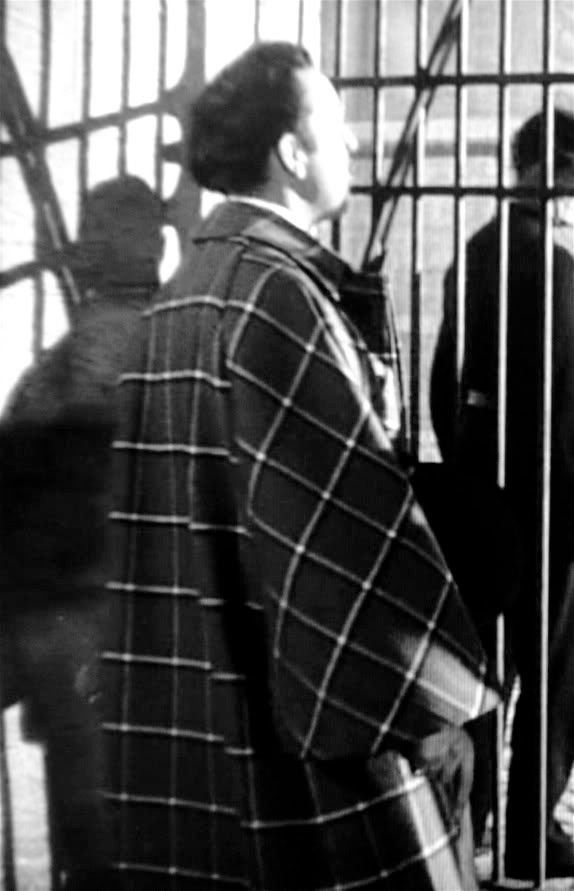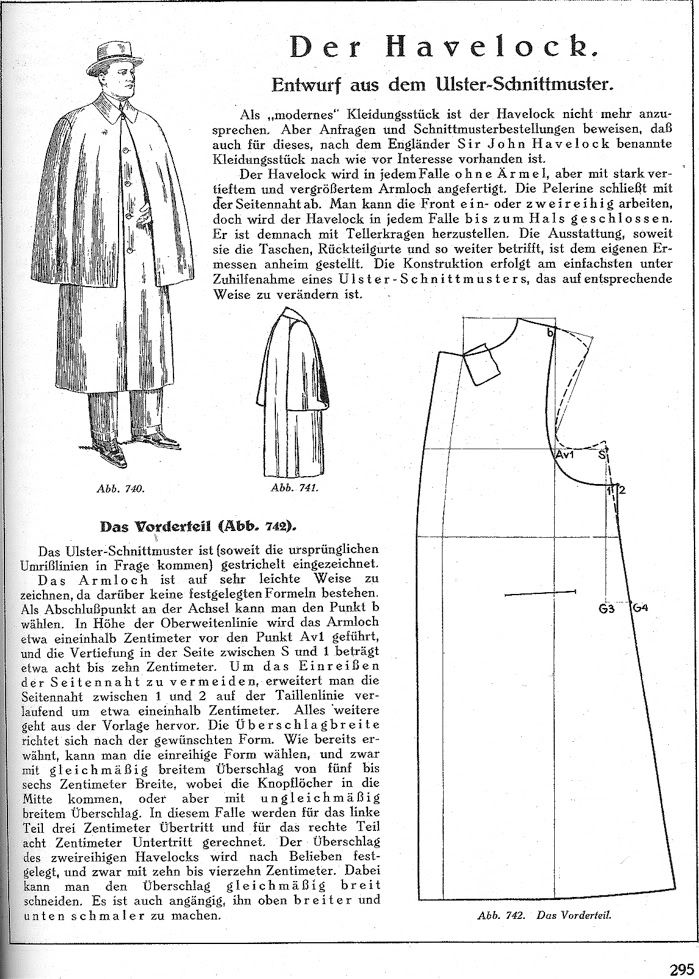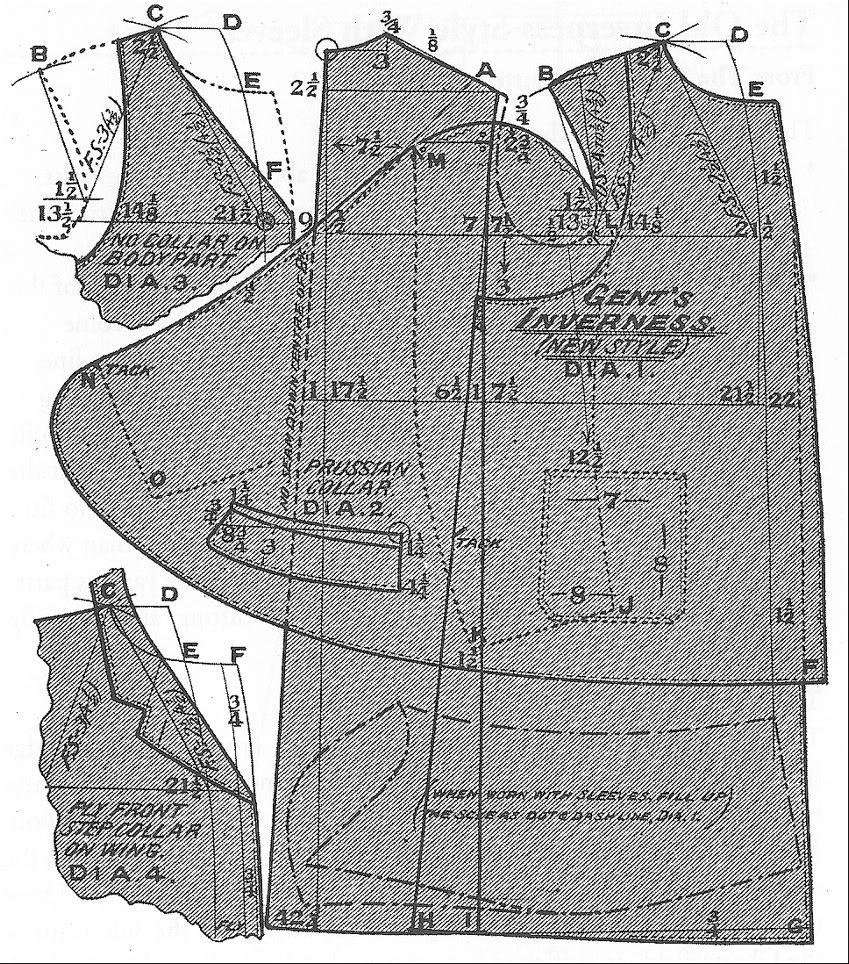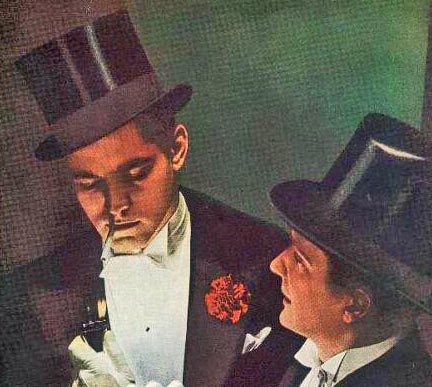What you always wanted to know about Elegance, but were afraid to ask!
-
Guest
Thu Sep 25, 2008 4:39 am
Here is the information straight from the caption:
[i]A History of Men's Fashion, [/i]pg 124 wrote:Overcoats and Raincoats
Around 1900, the Chesterfield was considered to be the most elegant of town overcoats. It was single-breasted, semi-long, with velvet collar, ticket-pocket, fly-front to hide the buttons, and sack or slightly fitted back. It was the most popular coat on the eve of World War I (see preceding page).
The Ulster, in homespun or Harris tweed, was a heavier, double-buttoning coat worn for travel or in town. The king of cape-style coats, the Mac Farlane was associated with the image of a British gentleman halfway between the Prince of Wales on an autumn trip and Sherlock Holmes gliding through foggy London streets in winter. It was eventually considered to be stylish and practical as both traveling and evening attire, triumphing over the snide comments of the Journal des Tailleurs forty years earlier, on 1 January 1860: "But what does it matter, in the end, if well-bred people decide that it is proper to resemble hackney drivers, or seek to be as handsome as their servants?" As to rubber raincoats, such as the Mackintosh that appeared around 1840, they were hardly deemed stylish. Abel Leger nevertheless pointed out in his 1912 L'Elegance Masculine that "it is so practical that it can be excused for being ugly, for generally being smelly and for having all the unhealthy drawbacks of rubber which prevents evaporation of persperation."
From this language it sounds as though the Mac Farlane (not one word here) was possibly a type of ulster, especially with the reference to an "autumn trip" (i.e. country travel) and Sherlock Holmes. Perhaps the intended meaning is that it is the ultimate caped coat -- ultimate in form and not formality. Does anyone have the original text in French and care to check and comment?
pbc
-
Guest
Thu Sep 25, 2008 5:16 am
The linguistic discussion proves quite useful: "macfarlane" is a common noun in Romanian denoting a long overcoat with vertical slits in it where the arms come out and a cloak over it. A Romanian-English dictionary (the irony of iy!) gives "Inverness cape" as the English equivalent of the "Romanian" macfarlane. But strangest of all, the word appears to have entered the Romamian language via French! Talking about feeling like archaeologists putting together broken pieces and trying to make sense of them...
Costi
-
Guest
Mon Sep 29, 2008 2:37 pm
There are a few minor points I would like to make.
Firstly, Victorian and Edwardian cutter's texts often distinguish between the old styled Inverness cloak and a different version for evening dress. The former seems to have been cut looser and the latter, somewhat more sleekly and elegantly. The evening full dress version often had silk faced step notch collars, whereas the travelling daywear version had a stand up "Prussian" collar. However, not all evening full dress versions had step collars/lapels. English language texts call both an Inverness coat/cloak/cape.
However, neither the day or evening versions of the Inverness has a true cape - rather it really has wings, although few texts call it that. A cape implies something going all the way around the back but I have yet to see an Inverness cloak with a full cape extending all the way around, but would be happy to be corrected in case I am reading my patterns and explanations incorrectly. Mostly they look like this:

MacFarlane - je pense qui c'est Fréncossais!

Sator
-
Guest
Mon Sep 29, 2008 4:22 pm
Anonymous wrote:
MacFarlane - je pense qui c'est Fréncossais!

Sator
The Auld Alliance lives on

!
Frog in Suit
-
Guest
Mon Sep 29, 2008 6:51 pm
Sator,
It is my understanding that the
Macfarlane has wings only (In Germany the wings are called "Pelerine")

whereas the
Havelock, named after Major General Sir Henry Havelock has a cape. Apparently, Sir Havelock only had one arm left so he wanted for an overcoat which covered up lost arm and besides it was easy to put on.

Regards, le.gentleman
-
Guest
Tue Sep 30, 2008 12:28 am
One of my huge and highly authoritative German tailoring textbooks make it quite clear that the Havelrock has wings not a full cape:

The same text, as well as Müller, gives a pattern for "Der Inverneß" which has wings and a step collar faced with silk. Müller also gives a pattern for "der Havelrock" with "halber Pelerine" ie a half cape. All German textbooks use the word "Pelerine" to indicate both a cape as well as the wings of an Inverness cloak. Pelerine in German usually just means a cape. Müller calls a double breasted version of the Inverness with a full cape, a "Hohenzollernmantel" (Hohenzollern coat).
Cunnington & Beard states that the Inverness is " 'The new name for the Cape Paletot'. ...In the 1870's the cape was usually incomplete behind, being sewn into the side seams". So the wings sewn into the sides appear to be a later innovation.
Not a single English language text (British or American) ever mentions the name Havelrock once. So, if the MacFarlane is Fréncossais, then the Havelrock appears to be Deunglisch!
Sator
-
Guest
Tue Sep 30, 2008 1:35 am
Isn't the real point that le gentleman was making is that there was a version without top coat arms betneath the cape or wings?
-
Guest
Tue Sep 30, 2008 1:54 am
Anonymous wrote:Isn't the real point that le gentleman was making is that there was a version without top coat arms betneath the cape or wings?
The Inverness by definition lacks sleeves under the cape/wings. There is no such thing as a sleeved Inverness cloak.
If an overcoat had sleeves and full cape it would be called a caped Ulster.
-
Guest
Tue Sep 30, 2008 2:20 am
Anonymous wrote:Anonymous wrote:Isn't the real point that le gentleman was making is that there was a version without top coat arms betneath the cape or wings?
The Inverness by definition lacks sleeves under the cape/wings. There is no such thing as a sleeved Inverness cloak.
If an overcoat had sleeves and full cape it would be called a caped Ulster.
I thought that this thread was about Ulsters and le gentleman was suggesting that there was a
sleeveless Ulster called a Havelock - or is that, by definition then an Inverness? 'Havelock', incidentally,
is an English dress term but it means a flap of cloth extending from headgear to protect the neck from the sun and is of mainly military use.
-
Guest
Tue Sep 30, 2008 2:49 am
This thread has derailed massively and we have long left the subject of Ulsters behind us. It has become a linguistic untangling thread for overcoats in general! Welcome to the mess.
My point was that the German patterns for the Havelock are identical to those for the (also sleeveless) Inverness with a Prussian style collar given in English language texts. The Inverness and its German language bretheren, the Havelock (and probably the French MacFarlane) are all sleeveless cloaks with a cape or wing.
Thanks for the information about the usage of "Havelock: in English. Now, is that American or British English?

Sator
-
Guest
Tue Sep 30, 2008 3:06 am
Anonymous wrote:This thread has derailed massively and we have long left the subject of Ulsters behind us. It has become a linguistic untangling thread for overcoats in general! Welcome to the mess.
My point was that the German patterns for the Havelock are identical to those for the (also sleeveless) Inverness with a Prussian style collar given in English language texts. The Inverness and its German language bretheren, the Havelock (and probably the French MacFarlane) are all sleeveless cloaks with a cape or wing.
Thanks for the information about the usage of "Havelock: in English. Now, is that American or British English?

Sator
Gieves & Hawkes would probably claim the colonial Havelock - in practice a kind of stiff full pugaree. At least, on the rest of it, you have provided an admirable summary of the thread. The Inverness and the Ulster are clearly defined and we know that the French and the Germans have been applying English language names to items which already had other English language names.

-
Guest
Tue Sep 30, 2008 3:08 am
Let me muddy the waters a bit more. In my readings (no reference at the moment) was mention that an inverness could have "semi attached" sleeves, permitting the wearer to use them or not as desired. They were connected along the top, slightly to the rear. The cape was full. I can see where that might have been an earlier iteration, the sleeves being subsequently lost altogether due to their usual disuse.
Part of this whole problem lays in lack of a solid definition or list of official characteristics. There is no golden encyclopedia wherein the keepers of sartorial wisdom record exact characteristics of a garment at its inception. As with any other objects, people relate them to what they know, call it by the old name. Or perhaps they copy an established style and make a change here or there, giving it the same name. "Come see the new inverness I commissioned. I had the cape sewn into the rear seams for better warmth." Overcoats seem to be prone to generic categories since they are around for so long, become so familiar, and have so many modifications over time.
Which relates back to the original posting name debate - ulster/paddock/paletot/inverness/frock overcoat. The linguistic analysis is interesting, but I don't know that there is a definitive answer.
pbc
-
Guest
Tue Sep 30, 2008 3:23 am
Maybe it's a bit like Dr Johnson's dictionary definition of a horse as a 'neighing quadriped' - but we know one when we see it.
-
Guest
Tue Sep 30, 2008 3:25 am
Anonymous wrote:Maybe it's a bit like Dr Johnson's dictionary definition of a horse as a 'neighing quadriped' - but we know one when we see it.
Sorry - quadruped.
-
Guest
Tue Sep 30, 2008 7:36 am
Anonymous wrote:Let me muddy the waters a bit more. In my readings (no reference at the moment) was mention that an inverness could have "semi attached" sleeves, permitting the wearer to use them or not as desired.
I have found this one pattern which includes details for a sleeve:

Note the sleeve outline with the words "when worn with sleeves fill up the scye as dot and dash line".
It is by far and away the exception and the only one amongst about 6-8 patterns that show this novelty detail. All of the others are sleeveless.
Sator
-
Users browsing this forum: No registered users and 11 guests





